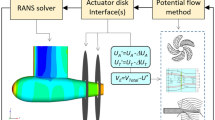Abstract
Wake alignment models are always included in the modern panel codes for marine propeller analysis. The wake alignment algorithms influence directly the rate of convergence and the accuracy of calculations. In the present work, firstly, four different numerical methods to implement the wake alignment algorithms for the steady calculation are described. They perform quite differently in terms of convergence history and convergence rate. The comparison with the other methods shows that the direct application of the unsteady method leads to a much slower convergence rate. Secondly, high-order numerical methods including second-order and fourth-order Runge–Kutta methods are introduced into the wake alignment, which results in high-order wake alignment algorithms. The analysis of the results shows that the high-order methods generate a different wake geometry from the low-order method. The thrust coefficient and torque coefficient have also been compared.
















Similar content being viewed by others
References
Hess JL, Valarezo WO (1985) Calculation of steady flow about propellers using a surface panel method. J Propuls Power 1(6):470–476
Kerwin JE, Kinnas SA, Lee JT, Shih WZ (1987) A surface panel method for the hydrodynamic analysis of ducted propellers. Trans SNAME 95:93–122
Baltazar JM, Falcão de Campos JAC, Bosschers J (2012) Open-water thrust and torque predictions of a ducted propeller system with a panel method. Int J Rotating Mach 1–11:2012
Berger S, Druckenbrod M, Pergande M, Abdel-Maksoud M (2014) A two-stage optimisation method for full-scale marine propellers working behind a ship. Ship Technol Res 61(2):64–79
Tian Y, Kinnas SA (2011) Modeling of leading edge vortex and its effects on propeller performance. In: Proceedings of the 2nd International Symposium on Marine Propulsors. Institute for Fluid Dynamics and Ship Theory (FDS)-Hamburg University of Technology (TUHH), German Society for Maritime Technology (STG) Hamurg, pp 350–359
He L (2010) Numerical simulation of unsteady rotor/stator interaction and application to propeller/rudder combination. PhD thesis, UT Austin
Tian Ye, Kinnas SA (2012) A wake model for the prediction of propeller performance at low advance ratios. Int J Rotating Mach 1–11:2012
Katz J, Plotkin A (2001) Low-speed aerodynamics, vol 13. Cambridge University Press, Cambridge
Hess JL (1972) Calculation of potential flow about arbitrary three-dimensional lifting bodies. Technical Report MDC J5679-01, McDonnell Douglas, Long Beach, California, October
Tian Y (2014) Leading edge vortex modeling and its effect on propulsor performance. PhD thesis, UT Austin
Pyo S (1995) Numerical modeling of propeller tip flows with wake sheet roll-up in three dimensions. PhD thesis, MIT
MOERI (2008) Moeri container ship (KCS). http://www.simman2008.dk/KCS/kcs_geometry.htm
Chiu YD, Peters DA (1988) Numerical solutions of induced velocities by semi-infinite tip vortex lines. J Aircr 25(8):684–694
Acknowledgments
The first author is sponsored by China Scholarship Council. Thanks also to our colleague Stephan Berger in Hamburg University of Technology who provided the RANS calculation results.
Author information
Authors and Affiliations
Corresponding author
About this article
Cite this article
Wang, Y., Abdel-Maksoud, M. & Song, B. Convergence of different wake alignment methods in a panel code for steady-state flows. J Mar Sci Technol 21, 567–578 (2016). https://doi.org/10.1007/s00773-016-0375-0
Received:
Accepted:
Published:
Issue Date:
DOI: https://doi.org/10.1007/s00773-016-0375-0




